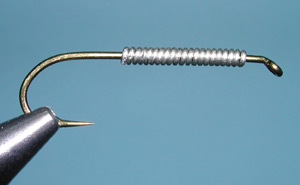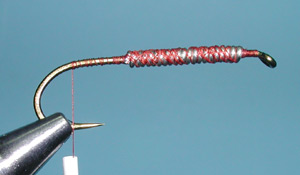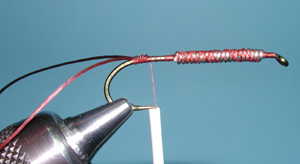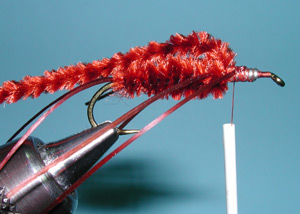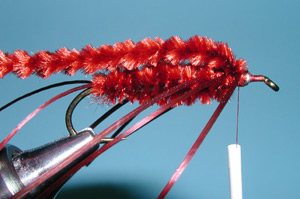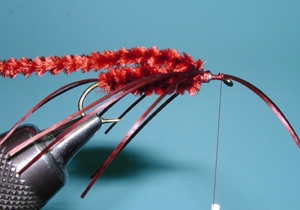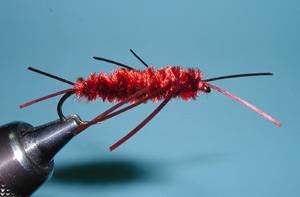Pat’s Rubberlegs – a proven pattern with true grit
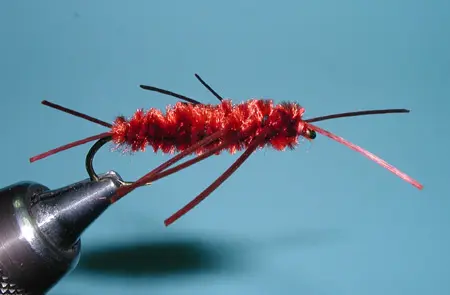
Pat’s Rubberlegs, Brown
Tying Instructions
| Materials
to Order Material, click the link |
|
|---|---|
| Hook | Daiichi 2220 #6-10 |
| Thread | Uni-thread 8/0 , Camel |
| Head | Uni-thread 8/0 , Camel |
| Weight | 0.015 Leadfree wire |
| Body | Medium Chenille, Brown |
| Tail | Flexfloss, Brown |
| Legs | Flexfloss, Brown |
| Antennae | Flexfloss, Brown |
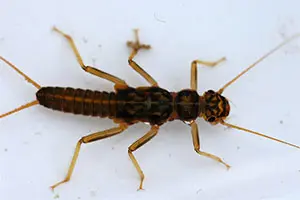

Pat Bennett
Pat’s Rubberlegs
Pat’s Rubberlegs is also known as Jimmy Legs, Knotty Girls, Restless Stone, The Turd, and The Pickle. The pattern was constructed by fly fishing guide, Pat Bennett, who works out of the Hyde shop in Island Park, Idaho.
According to Pat:
“I began tying my first Pat’s Brown Rubber Legsin 1995 while at a cabin in Island Park that my grandfather built. Was there on leave while in the Army floating Box Canyon on one man pontoon boats with my son, Mike. We were using Montana nymphs and catching a few fish. I started looking under rocks and looking at the stone fly nymphs and thought they looked more brown than black.
So I went to a fly shop and bought true brown chenille, some lead less fly tying weight, and some super floss that I thought was brown but it was true olive. True olive has a hint of brown in it and I didn’t like the rubber legs that were being used on the girdle bugs and so used the super floss. My son and I started catching a lot of fish on them. I started guiding in 1997 when I retired from the Army after 22 years of active service. By then had started tying the rubber legs in about 5 or 6 different colors and they proved very successful with clients. Solitude Fly Company picked it up in 2003 andhas since been a staple fly amongst anglers.”
Other names, similar patterns
The other fly distributors created similar patterns under different names. Jimmy Legs is a variation from Idylwild Flies in which the legs are pre-knotted and tied on a bent hook, such as a Daiichi 1730. Knotty Girls also have knotted legs but they are usually round rubber material. Restless Stone is another name as marketed by Umpqua. Whatever the name, the pattern works quite well and has become a favorite among guides.
Girdle Bug Origin
The pattern is a variation off an older pattern known as the Girdle Bug. This pattern was developed in the 1930’s by Frank McGinnis of Anaconda, MT. He developed this pattern while fishing the Big Hole River. Originally, Frank would take apart women’s girdles and remove the white round rubber strands for legs on a chenille body stonefly. Frank referred to his creation as the McGinnis Rubberlegs but other anglers preferred the name, Girdle Bug.
Ugly Bug transition
In the 1980’s an all-black round rubberlegs pattern was marketed as the Ugly Bug Nymph. A new spandex rubber material became available in the 1990’s such as Super Floss, Flex Floss, Life Flex, and Spanflex. Pat Bennett was one of the first tiers to utilize Super Floss for the legs and it has become preferred since then. It is much more durable and transparent than rubberleg material and very supple with lifelike movement in the water. The use of Silicone material for the legs assists the pattern with a quicker descent.
Mickey Wooton, a guide out of West Yellowstone, came up with a nice variation of trimming the chenille at the abdomen for a flattened taper and replaced the antennae and tails with Krystalflash and Goose Biots, respectively. Solitude Fly Company introduced a recent version of the rubberlegs with the TJ Hooker. The pattern includes a slotted tungsten bead onto a jig hook and added chickabou marabou for a tail providing extra movement.
Fish Pat’s Rubberlegs in the riffles and runs of fast moving water. It also makes a great pattern for short line nymphing. The weight of the pattern allows it to quickly sink into deeps slots and pools. A great rig setup with a Beadhead dropper such as a Prince Nymph or Hare’s Ear.
Variations
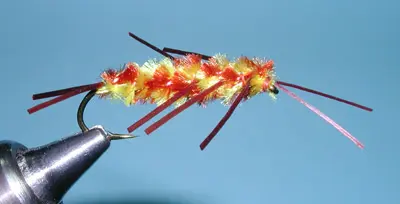
Pat’s Rubberlegs, Brown/Yellow
| Hook | Daiichi 2220 #6-10 |
| Thread | Uni-thread 8/0 ,Orange |
| Head | Uni-thread 8/0 ,Orange |
| Weight | 0.015 Leadfree wire |
| Body | Variegated Chenille, Brown/Yellow |
| Tail | Flexfloss, Brown |
| Legs | Flexfloss, Brown |
| Antennae | Flexfloss, Brown |
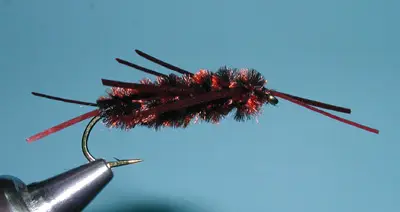
Pat’s Rubberlegs, Brown/Black
| Hook | Daiichi 2220 #6-10 |
| Thread | Uni-thread 8/0 ,Black |
| Head | Uni-thread 8/0 ,Black |
| Weight | 0.015 Leadfree wire |
| Body | Variegated Chenille, Brown/Black |
| Tail | Flexfloss, Brown |
| Legs | Flexfloss, Brown |
| Antennae | Flexfloss, Brown |
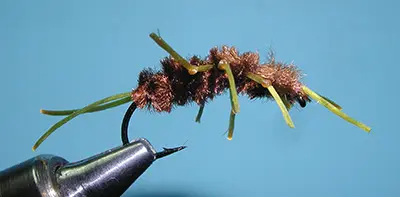
Jimmy Legs Stonefly, Brown
| Hook | Daiichi 1730 #6-10 |
| Thread | Danville 6/0 ,Brown |
| Danville 6/0 ,Brown | |
| Weight | 0.015 Leadfree wire |
| Body | Medium Chenille, Dark Brown |
| Tail | Life Flex, Olive |
| Legs | Life Flex, Olive |
| Antennae | Life Flex, Olive |
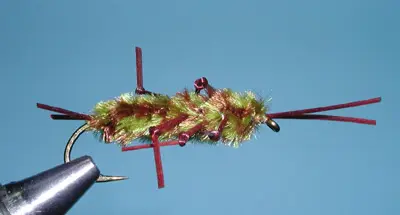
Knotty Girl, Olive/Brown
| Hook | Daiichi 2220 #6-10 |
| Thread | Uni-thread 8/0 ,Olive |
| Head | Uni-thread 8/0 , Camel |
| Weight | 0.015 Leadfree wire |
| Body | Variegated Chenille, Olive/Brown |
| Tail | Flexfloss, Brown |
| Legs | Flexfloss, Brown Knotted |
| Antennae | Flexfloss, Brown |
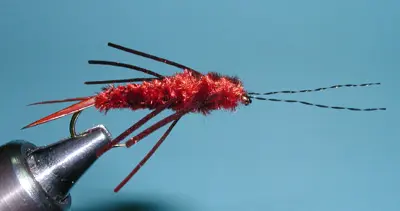
Wooten’s Rubberlegs variation, Brown
| Hook | Daiichi 2220 #6-10 |
| Thread | Uni-thread 8/0 ,Camel |
| Head | Uni-thread 8/0 ,Camel |
| Weight | 0.015 Leadfree wire |
| Body | Medium Chenille, Browntrimmed at abdomen |
| Tail | Goose Biots, Brown |
| Legs | Flexfloss, Brown |
| Antennae | Krystalflash, Black |
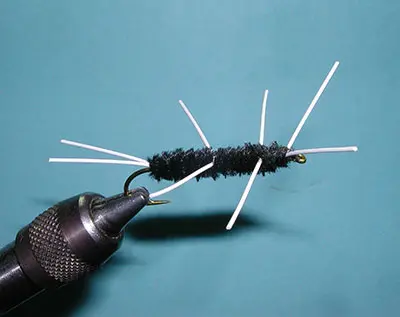
McGinnis Rubberlegs aka Girdle Bug
| Hook | TMC 300, size #4-12 |
| Thread | Uni-Thread 6/0, Black |
| Head | Uni-Thread 6/0, Black |
| Weight | 0.020 Leadfree wire |
| Body | Medium Chenille, Black |
| Tail | Round Rubberlegs White |
| Legs | Round Rubberlegs White |
| Antennae | Round Rubberlegs White |

Rubberlegged Black Stone – Ugly Bug
| Hook | TMC 5263 #6-8 |
| Thread | Uni-thread 8/0 , Black |
| Head | Uni-thread 8/0 , Black |
| Weight | 0.020 Leadfree wire |
| Body | Black Beaver Dubbing with UV Black Ice Dubbing Blend |
| Wingcase | Black Swiss Straw |
| Tail | Black Rubber |
| Legs | Black Rubber |
| Antennae | Black Rubber |
| Ribbing | Copper Wire over abdomen |
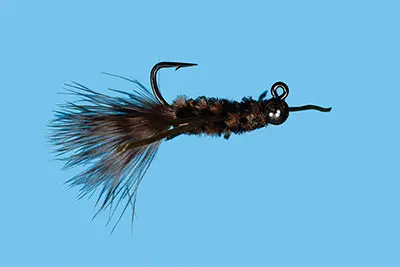
TJ Hooker, Black & Brown
| Hook | Firehole 516 #8-12 |
| Thread | Uni-thread 6/0 ,Camel |
| Bead | Mottled Tungsten Slot Bead, Olive |
| Weight | 0.020 Leadfree wire |
| Body | Variegated Chenille, Black and Brown |
| Tail | Mini Grizzly Marabou, Tan |
| Legs | Flexfloss, Olive |
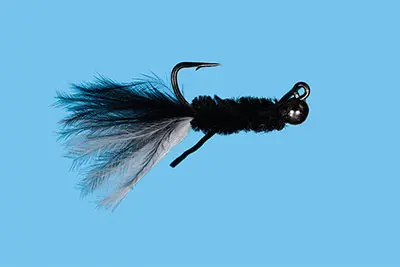
TJ Hooker, Black
| Hook | Firehole 516, size #8-12 |
| Thread | Uni-Thread 6/0, Black |
| Bead | Mottled Tungsten Slot, Black |
| Weight | 0.020 Leadfree wire |
| Body | Medium Chenille, Black |
| Tail | Marabou, White and Black |
| Legs | Round Rubberlegs Black |

